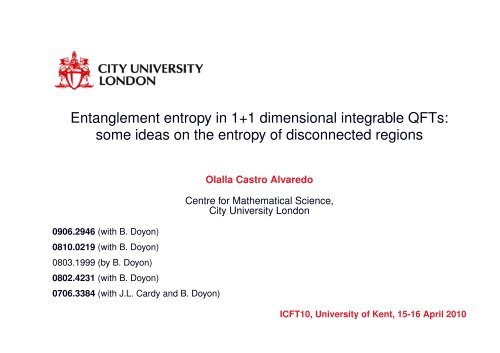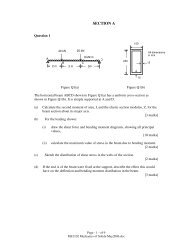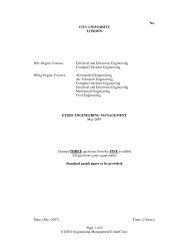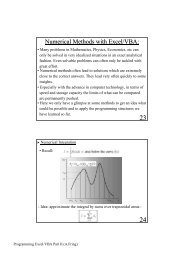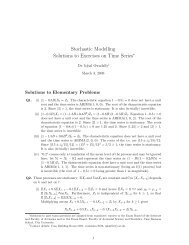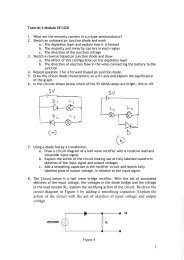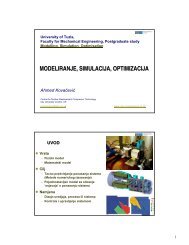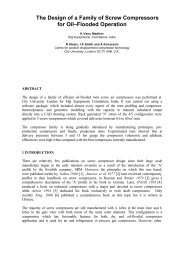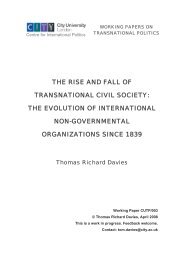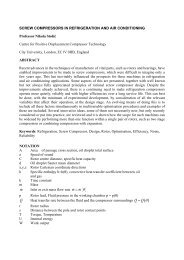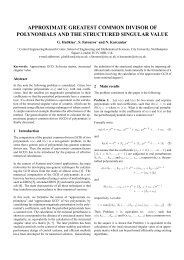entanglement entropy of disconnected regions - Staff.city.ac.uk - City ...
entanglement entropy of disconnected regions - Staff.city.ac.uk - City ...
entanglement entropy of disconnected regions - Staff.city.ac.uk - City ...
Create successful ePaper yourself
Turn your PDF publications into a flip-book with our unique Google optimized e-Paper software.
Entanglement <strong>entropy</strong> in 1+1 dimensional integrable QFTs:<br />
some ideas on the <strong>entropy</strong> <strong>of</strong> <strong>disconnected</strong> <strong>regions</strong><br />
0906.2946 (with B. Doyon)<br />
0810.0219 (with B. Doyon)<br />
0803.1999 (by B. Doyon)<br />
0802.4231 (with B. Doyon)<br />
0706.3384 (with J.L. Cardy and B. Doyon)<br />
Olalla Castro Alvaredo<br />
Centre for Mathematical Science,<br />
<strong>City</strong> University London<br />
ICFT10, University <strong>of</strong> Kent, 15-16 April 2010
Entanglement in quantum mechanics<br />
• A quantum system is in an entangled state if performing a localised measurement (in<br />
sp<strong>ac</strong>e and time) may instantaneously affect local measurements far away.<br />
A typical example: a pair <strong>of</strong> opposite-spin electrons:<br />
|ψ〉 = 1 √<br />
2<br />
(|↑ ↓ 〉 + |↓ ↑ 〉) ,<br />
〈Â〉 = 〈ψ|Â|ψ〉<br />
• What is special: Bell’s inequality says that this cannot be described by local variables.<br />
• A situation that looks similar to |ψ〉 but without <strong>entanglement</strong> is a f<strong>ac</strong>torizable state:<br />
| ˆψ〉 = 1 2 (|↑ ↓ 〉 + |↓ ↑ 〉 + |↑ ↑ 〉 + |↓ ↓ 〉) = 1 2<br />
(|↑ 〉 + |↓ 〉) ⊗ (|↑ 〉 + |↓ 〉)<br />
• This is particular to pure states. Mixed states are described by density matrices<br />
ρ = ∑ α<br />
p α |ψ α 〉〈ψ α | ,<br />
〈Â〉 = Tr(ρÂ)<br />
(for pure states, ρ = |ψ〉〈ψ|; for finite temperature, ρ = e −H/kT ).
How and why to measure (or quantify) quantum <strong>entanglement</strong>?<br />
• Measuring quantum <strong>entanglement</strong> is useful: as such measurement may have<br />
applications to the design <strong>of</strong> (still theoretical) quantum computers. It is also a<br />
fundamental property <strong>of</strong> quantum systems.<br />
• In pure states, there are various proposals to measure quantum <strong>entanglement</strong>.<br />
Consider the <strong>entanglement</strong> <strong>entropy</strong> and let us look at a more complicated system:<br />
– With the Hilbert sp<strong>ac</strong>e a tensor product H = s 1 ⊗ s 2 ⊗ · · · ⊗ s N = A ⊗<br />
given state |gs〉 ∈ H, calculate the reduced density matrix:<br />
01<br />
01<br />
01<br />
si<br />
x i+1 x<br />
ρ A = Tr Ā (|gs〉〈gs|)<br />
01<br />
01<br />
01<br />
01<br />
... s s ...<br />
i−1 x<br />
01<br />
01<br />
01 01 01 01 01 01<br />
01 01 01 01 01 A<br />
s<br />
s<br />
x i+L−1 x i+L<br />
– The <strong>entanglement</strong> <strong>entropy</strong> is the resulting von Neumann <strong>entropy</strong>:<br />
S A = −Tr A (ρ A log(ρ A )) = −<br />
∑<br />
eigenvalues <strong>of</strong> ρ A<br />
λ≠0<br />
...<br />
λ log(λ)<br />
Ā, and a
Interpretation <strong>of</strong> the <strong>entanglement</strong> <strong>entropy</strong><br />
• It is the <strong>entropy</strong> that is measured in a subsystem A, once the rest <strong>of</strong> the system Ā – the<br />
environment – is forgotten.<br />
If we think A is all there is, we will think the system is in a mixed state, with density matrix given by<br />
ρ A . The <strong>entropy</strong> <strong>of</strong> ρ A measures how mixed ρ A is. This mixing is due to the connections, or<br />
<strong>entanglement</strong>, with the environment.<br />
• It was proposed as a way to understand bl<strong>ac</strong>k hole <strong>entropy</strong><br />
[Bombelli, Koul, Lee, Sorkin 1986].<br />
• Then it was proposed as a measure <strong>of</strong> <strong>entanglement</strong><br />
[Bennet, Bernstein, Popescu, Schum<strong>ac</strong>her 1996].<br />
• Examples:<br />
– Tensor product state:<br />
|gs〉 = |A〉 ⊗ |Ā〉 ⇒ ρ A = |A〉〈A| ⇒ S A = −1 log(1) = 0.
– The maximally entangled state |gs〉 = 1 √<br />
2<br />
(| ↑ ↓ 〉 + | ↓ ↑ 〉):<br />
ρ 1 st spin = 1 (<br />
2 (| ↑ 〉〈 ↑ |+| ↓ 〉〈 ↓ |) ⇒ S 1 st spin = −2× − log( √ )<br />
2)<br />
= log(2)<br />
• In general the <strong>entanglement</strong> <strong>entropy</strong> is not “directional”, that is S A = S A<br />
.<br />
• We can think <strong>of</strong> the <strong>entropy</strong> as counting the number <strong>of</strong> “connections” between A and Ā.
Scaling limit<br />
• Say |gs〉 is a ground state <strong>of</strong> some local spin-chain Hamiltonian, and that the chain is<br />
infinitely long.<br />
• An important property <strong>of</strong> |gs〉 is the correlation length ξ:<br />
〈gs|ˆσ iˆσ j |gs〉 ∼ e −|i−j|/ξ as |i − j| → ∞<br />
• If there are parameters in the Hamiltonian (e.g. temperature, magnetic field etc) such that<br />
for certain values ξ → ∞. This is a quantum critical point.<br />
• We may adjust these parameters in such a way that L, ξ → ∞ in such as way that the<br />
length L <strong>of</strong> A is proportional to ξ: L/ξ = mr.<br />
• This is the scaling limit, and what we obtain is a quantum field theory. m here is a<br />
mass scale – we may have many masses m α associated to many correlation lengths –<br />
and r is the dimensionful length <strong>of</strong> region A in the scaling limit.<br />
• The resulting <strong>entanglement</strong> <strong>entropy</strong> has a universal part: a part that does not depend<br />
very much on the details <strong>of</strong> the Hamiltonian.
Short- and large-distance <strong>entanglement</strong> <strong>entropy</strong><br />
Consider ε = 1/(m 1 ξ), a non-universal QFT cut<strong>of</strong>f with dimenions <strong>of</strong> length. Then:<br />
• Short distance: 0 ≪ L ≪ ξ, logarithmic behavior [Holzhey, Larsen, Wilczek 1994;<br />
Calabrese, Cardy 2004]<br />
S A ∼ c ( r<br />
)<br />
3 log ε<br />
• Large distance: 0 ≪ ξ ≪ L, saturation<br />
S A ∼ − c 3 log(m 1ε) + U<br />
where c is the central charge <strong>of</strong> the corresponding critical point. One <strong>of</strong> the main results <strong>of</strong><br />
our work was to find the next-to-leading order correction to this behavior.
Large distance corrections<br />
[J.L. Cardy, O.C.A., B. Doyon 2007], [O.C.A, B. Doyon 2008], [B. Doyon 2008]<br />
Our result: for any integrable QFT, the <strong>entropy</strong> with its first correction to saturation at large<br />
distances is:<br />
S A ∼ − c 3 log(mε) + U − 1 8 K 0(2rm) + O ( e −3rm)<br />
where m is the mass <strong>of</strong> the particle.<br />
• The next-to-leading order correction term depends only on the particle spectrum, but not<br />
on the inter<strong>ac</strong>tion between particles (i.e. not the S-matrix).<br />
• In our work we have extended this result to any integrable QFT (even non-integrable<br />
[B. Doyon 2008]).<br />
• In a recent work [O.C.A, B. Doyon 2008] we have also computed all the remaining<br />
higher order corrections for the special case <strong>of</strong> the Ising field theory with and without a<br />
boundary.
Partition functions on multi-sheeted Riemann surf<strong>ac</strong>es<br />
[Callan, Wilczek 1994; Holzhey, Larsen, Wilczek 1994]<br />
• We can use the “replica trick” for evaluating the <strong>entanglement</strong> <strong>entropy</strong>:<br />
S A = −Tr A (ρ A log(ρ A )) = − lim<br />
n→1<br />
d<br />
dn Tr A(ρ n A)<br />
• For integer numbers n <strong>of</strong> replicas, in the scaling limit, this is a partition function on a<br />
Riemann surf<strong>ac</strong>e:<br />
A〈φ|ρ A |ψ〉 A<br />
∼<br />
Tr A (ρ n A) ∼ Z n =<br />
∫<br />
[dϕ] Mn exp<br />
| ψ ><br />
< φ| A<br />
r<br />
[<br />
−<br />
∫<br />
]<br />
d 2 x L[ϕ](x)<br />
M n<br />
M n :
Branch-point twist fields<br />
[J.L. Cardy, O.C.A, B. Doyon 2007]<br />
• Consider many copies <strong>of</strong> the QFT model on the usual R 2 :<br />
L (n) [ϕ 1 , . . . , ϕ n ](x) = L[ϕ 1 ](x) + . . . + L[ϕ n ](x)<br />
• There is an obvious symmetry under cyclic exchange <strong>of</strong> the copies:<br />
L (n) [σϕ 1 , . . . , σϕ n ] = L (n) [ϕ 1 , . . . , ϕ n ] , with σϕ i = ϕ i+1 mod n<br />
• Whenever we have an internal symmetry in a QFT we can associate a twist field to it. We<br />
will call the fields associated to the Z n symmetry introduced here branch point twist<br />
fields.
• Another twist field ˜T is associated to the inverse symmetry σ −1 , and we have<br />
∫<br />
[ ∫<br />
]<br />
〈T (0) ˜T (r)〉 L (n) ∝ [dϕ 1 · · · dϕ n ] R<br />
2 exp − d 2 x L (n) [ϕ 1 , . . . , ϕ n ](x)<br />
C 0,r R 2<br />
= Z n = Tr A (ρ n A)<br />
C 0,r :<br />
ϕ<br />
i+1<br />
( x ) T(0) T ~ ( r)<br />
ϕ i<br />
( x)
Locality in QFT<br />
• A field O(x) is local in QFT if measurements associated to this field are quantum<br />
mechanically independent from measurements <strong>of</strong> the energy density (or Lagrangian<br />
density) at sp<strong>ac</strong>e-like distances. That is, equal-time commutation relations vanish:<br />
[O(x, t = 0), L (n) (x ′ , t = 0)] = 0 (x ≠ x ′ ) .<br />
• This means that:<br />
O( x)<br />
(n)<br />
L [ ϕ, 1 ϕ ,..., ϕ ]<br />
2 n<br />
( x’ )<br />
=<br />
• Branch-point twist fields are local fields in the n-copy theory.
Hence we have<br />
Short- and large-distance <strong>entanglement</strong> <strong>entropy</strong> revisited<br />
Z n = D n ε 2d n<br />
〈T (0) ˜T (r)〉 L<br />
(n) ,<br />
S A = − lim<br />
n→1<br />
d<br />
dn Z n<br />
where D n is a normalisation constant, and d n is the scaling dimension <strong>of</strong> T [Calabrese,<br />
Cardy 2004]:<br />
d n = c<br />
12<br />
(<br />
n − 1 )<br />
n<br />
• Short distance: 0 ≪ L ≪ ξ, logarithmic behavior<br />
〈T (0) ˜T (r)〉 L (n) ∼ r −2d n<br />
⇒ S A ∼ c 3 log ( r<br />
ε<br />
)<br />
• Large distance: 0 ≪ ξ ≪ L, saturation<br />
〈T (0) ˜T (r)〉 L (n) ∼ 〈T 〉 2 L (n) ⇒ S A ∼ − c 3 log(m 1ε) + U
Form f<strong>ac</strong>tors and two-point functions in integrable models<br />
• The two-point function <strong>of</strong> branch-point twist fields can be decomposed as follows, giving<br />
a large-distance expansion:<br />
〈T (0) ˜T (r)〉 = 〈gs|T (0) ˜T (r)|gs〉<br />
∑<br />
= 〈gs|T (0)|k〉〈k| ˜T (r)|gs〉<br />
state k<br />
where ∑ k<br />
|k〉〈k| is a sum over a complete set <strong>of</strong> states in the Hilbert sp<strong>ac</strong>e <strong>of</strong> the theory.<br />
• The matrix elements 〈gs|T (0)|k〉 are called form f<strong>ac</strong>tors.<br />
• For integrable models, an specific program exists (form f<strong>ac</strong>tor program) that allows their<br />
ex<strong>ac</strong>t (non-perturbative) computation.<br />
• However the program needs to be modified to include twist fields correctly.<br />
• Main challenge: analytic continuation from n = 1, 2, . . . to n ∈ [1, ∞).
The <strong>entropy</strong> <strong>of</strong> <strong>disconnected</strong> <strong>regions</strong><br />
• Consider again a quantum spin chain which we now divide into four different <strong>regions</strong><br />
(periodic boundary conditions)<br />
01<br />
01<br />
01<br />
01<br />
01<br />
01<br />
01<br />
01<br />
01 01 01 01 01<br />
01<br />
01 01 01 01 01<br />
01<br />
01<br />
01<br />
01<br />
01<br />
01<br />
01<br />
01 01 01 01 01<br />
01<br />
01 01 01 01 ... x s x s ... x s x ... ... x s x s j+1 x ... x s x ...<br />
i<br />
i+1 x<br />
i+L−1<br />
j<br />
j+M−1<br />
D<br />
A<br />
: L sites<br />
C<br />
B<br />
: M sites<br />
D<br />
• A problem <strong>of</strong> current interest is finding the <strong>entanglement</strong> <strong>entropy</strong> <strong>of</strong> the region A ∪ B<br />
with respect to the rest <strong>of</strong> the system (where A and B are now “<strong>disconnected</strong>”)<br />
S A∪B = −Tr A∪B (ρ A∪B ln(ρ A∪B ))<br />
with<br />
ρ A∪B = Tr C∪D (|gs〉〈gs|)<br />
and |gs〉 is again the ground state <strong>of</strong> the chain (a pure state).
The <strong>entropy</strong> <strong>of</strong> <strong>disconnected</strong> <strong>regions</strong> and the replica trick<br />
• We can use the “replica trick” for evaluating the <strong>entanglement</strong> <strong>entropy</strong> as before:<br />
S A∪B = −Tr A∪B (ρ A∪B log(ρ A∪B )) = − lim<br />
n→1<br />
d<br />
dn Tr A∪B(ρ n A∪B)<br />
• For integer numbers n <strong>of</strong> replicas, in the scaling limit, this is again a partition function on<br />
a (more complicated) Riemann surf<strong>ac</strong>e:<br />
A∪B〈φ|ρ A∪B |ψ〉 A∪B<br />
∼<br />
Tr A∪B (ρ n A∪B) ∼ Z n =<br />
∫<br />
[dϕ] Mn exp<br />
[ ∫<br />
]<br />
− d 2 x L[ϕ](x)<br />
M n<br />
M n :<br />
n<br />
2<br />
.<br />
.<br />
1<br />
A<br />
B
The <strong>entropy</strong> <strong>of</strong> <strong>disconnected</strong> <strong>regions</strong> from twist fields<br />
• Similarly to the previous case, the partition function <strong>of</strong> the n-sheeted Riemann surf<strong>ac</strong>e<br />
can be expressed in terms <strong>of</strong> a correlation function <strong>of</strong> twist fields. In this case it is a four<br />
point function:<br />
〈T (r 1 ) ˜T (r 2 )T (r 3 ) ˜T (r 4 )〉 L<br />
(n)<br />
∫<br />
[ ∫<br />
]<br />
∝ [dϕ 1 · · · dϕ n ] R<br />
2 exp − d 2 x L (n) [ϕ 1 , . . . , ϕ n ](x)<br />
C 0,r R 2<br />
= Z n = Tr A∪B (ρ n A∪B)<br />
• From a computational point <strong>of</strong> view, it is much more challenging to compute a four-point<br />
function than a two-point function, even in the two-particle approximation.<br />
• Some limiting cases, such as r 1,2 ≪ r 3,4 can be analyzed more easily.
Extensivity<br />
• A property <strong>of</strong> the <strong>entropy</strong> <strong>of</strong> <strong>disconnected</strong> <strong>regions</strong> that has been recently investigated is<br />
its extensivity.<br />
• Extensivity implies that the <strong>entropy</strong> <strong>of</strong> <strong>disconnected</strong> <strong>regions</strong> can be expressed in terms <strong>of</strong><br />
the individual entropies <strong>of</strong> connected domains<br />
S A∪B = S A + S B + S C + S D − 1 2 (S A∪C + S B∪C + S A∪D + S B∪D )<br />
• In our twist field picture it would imply a relationship <strong>of</strong> the type<br />
d<br />
dn 〈T (r 1) ˜T (r 2 )T (r 3 ) ˜T d<br />
[<br />
(r 4 )〉 ∼ lim 〈T (r 1 )<br />
n→1 dn<br />
˜T (r 2 )〉 + 〈T (r 3 ) ˜T (r 4 )〉<br />
+〈T (r 1 ) ˜T (r 4 )〉 + 〈T (r 2 ) ˜T (r 3 )〉 − 〈T (r 1 ) ˜T (r 3 )〉 − 〈T (r 2 ) ˜T<br />
]<br />
(r 4 )〉<br />
lim<br />
n→1
Some simple limit cases<br />
• When r 1 , r 2 ≪ r 3 , r 4 the 4-point function f<strong>ac</strong>torizes as<br />
lim<br />
n→1<br />
d<br />
dn 〈T (r 1) ˜T (r 2 )T (r 3 ) ˜T (r 4 )〉 → lim<br />
n→1<br />
= lim<br />
n→1<br />
〈T (r 3 ) ˜T (r 4 )〉<br />
} {{ }<br />
=1<br />
+ lim<br />
n→1<br />
〈T (r 1 ) ˜T (r 2 )〉<br />
} {{ }<br />
=1<br />
d<br />
dn 〈T (r 1) ˜T (r 2 )〉<br />
lim<br />
n→1<br />
} {{ }<br />
=−S A<br />
d<br />
lim<br />
n→1 dn 〈T (r 3) ˜T (r 4 )〉 = −S A − S B ,<br />
} {{ }<br />
=−S B<br />
d<br />
dn 〈T (r 1) ˜T (r 2 )〉〈T (r 3 ) ˜T (r 4 )〉<br />
• Regions A and B are so far from e<strong>ac</strong>h other (the size <strong>of</strong> region C tends to ∞ whilst the<br />
sizes <strong>of</strong> <strong>regions</strong> A and B are fixed and finite) that the bipartite <strong>entropy</strong> becomes simply<br />
the sum <strong>of</strong> the <strong>entanglement</strong> <strong>entropy</strong> between e<strong>ac</strong>h <strong>of</strong> the <strong>regions</strong> and the rest <strong>of</strong> the<br />
system.
• When r 1 ≪ r 2 and r 3 ≪ r 4 the 4-point function f<strong>ac</strong>torizes as<br />
d<br />
lim<br />
n→1 dn 〈T (r 1) ˜T (r 2 )T (r 3 ) ˜T d<br />
(r 4 )〉 → lim<br />
n→1 dn 〈T (r 1)〉〈 ˜T (r 2 )T (r 3 )〉〈 ˜T (r 4 )〉<br />
= lim 〈T 〉 2 d<br />
n→1 dn 〈 ˜T (r 2 )T (r 3 )〉 + lim 〈 ˜T (r 2 )T (r 3 )〉 d 〈T 〉2<br />
n→1 dn<br />
d〈T 〉<br />
= −S C + 2 lim<br />
n→1 dn<br />
• In this case the size <strong>of</strong> <strong>regions</strong> A and B tends to ∞ while the size <strong>of</strong> region C is fixed<br />
and finite. Region C only sees the infinite <strong>regions</strong> A and B and its <strong>entanglement</strong> with<br />
them is S C . To this we add the two “boundary” contributions from the <strong>entanglement</strong> <strong>of</strong> A<br />
and B with D.<br />
• These two examples are compatible with extensivity <strong>of</strong> the <strong>entanglement</strong> <strong>entropy</strong>!
Non-extensivity<br />
• In recent years numerical and analytical evidence <strong>of</strong> the non-extensivity <strong>of</strong> the<br />
<strong>entanglement</strong> <strong>entropy</strong> has been found. In f<strong>ac</strong>t, it appears that the <strong>entropy</strong> is only<br />
extensive for the massless free Fermion in 1+1 dimensions [Casini, Huerta 2004;<br />
Calabrese, Cardy 2004/2005, Casini, Fosco, Huerta 2005]<br />
• [Caraglio, Gliozzi 2008] found analitical and numerical evidence (critical Ising model) <strong>of</strong><br />
non-extensivity. [Casini, Huerta 2009] have also shown analytically the non-extensivity <strong>of</strong><br />
the <strong>entropy</strong> for a massive free Fermion model and small mass. The <strong>entanglement</strong><br />
<strong>entropy</strong> <strong>of</strong> <strong>disconnected</strong> <strong>regions</strong> has been shown to be non-extensive for generic CFTs in<br />
[Calabrese, Cardy, Toni 2009]. Numerical evidence for the free comp<strong>ac</strong>tified Boson was<br />
also provided there.<br />
• Numerical computations <strong>of</strong> the <strong>entanglement</strong> <strong>entropy</strong> <strong>of</strong> <strong>disconnected</strong> <strong>regions</strong>, showing<br />
its non-extensivity have been carried out for the critical Ising model [Alba, Tagli<strong>ac</strong>ozzo,<br />
Calabrese 2009] and for the XY integrable spin chain [Fagotti, Calabrese 2010].<br />
• Preliminary results <strong>of</strong> our work appear to indicate that extensivity is also violated when<br />
looking at higher order corrections to the <strong>entanglement</strong> <strong>entropy</strong>, when the sizes <strong>of</strong> all<br />
<strong>regions</strong> are large and <strong>of</strong> the same order <strong>of</strong> magnitude.
Conclusions<br />
• The main result <strong>of</strong> our work has been the derivation <strong>of</strong> the first correction to saturation<br />
<strong>of</strong> the <strong>entanglement</strong> <strong>entropy</strong> in any IQFT and the computation <strong>of</strong> all corrections for the<br />
Ising model (with and without boundaries).<br />
• The key ingredients for this are the introduction <strong>of</strong> branch point twist fields in terms <strong>of</strong><br />
whose two-point function the <strong>entropy</strong> can be evaluated. The form f<strong>ac</strong>tor program has<br />
been generalised to <strong>ac</strong>commodate branch point twist fields.<br />
• In this talk I have tried to indicate how our appro<strong>ac</strong>h could be pursued further to<br />
investigate the <strong>entanglement</strong> <strong>entropy</strong> <strong>of</strong> <strong>disconnected</strong> <strong>regions</strong> (two for a start).<br />
• The next-to-leading order correction to the <strong>entanglement</strong> <strong>entropy</strong> <strong>of</strong> two <strong>disconnected</strong><br />
<strong>regions</strong> involves multiple integrals over combinations <strong>of</strong> two- and four-particle form<br />
f<strong>ac</strong>tors <strong>of</strong> the twist fields whose analytic continuation in n is extremely involved.<br />
• Preliminary results suggest that some higher order correction to the <strong>entanglement</strong><br />
<strong>entropy</strong> <strong>of</strong> two <strong>disconnected</strong> <strong>regions</strong> are not compatible with extensivity.


